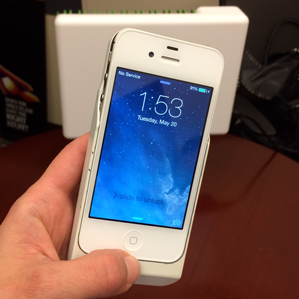Wireless Power from Across the Room
“Do you want us to charge your phone?” George Holmes asks. Normally, that would be an odd question. But Holmes is the vice president of sales and marketing for Energous, a company that is developing technology called WattUp that will allow you to charge smartphones, tablets, and other small gadgets from across a room without wires.

Energous hopes other companies will license this technology and build it into all kinds of products and places, so you can easily power your iPad while sitting on the couch browsing Instagram, or top off your phone while buying a coffee or playing Candy Crush in an airport. It will face competition, however, from a startup called Witricity that uses a different method, and already has the backing of some major electronics companies.
For now, WattUp’s technology is still in the demo stage, which means it’s not very good-looking. But it works, and during a visit to my San Francisco office, Holmes wants to show it off.
Devices can be charged wirelessly if they are connected to an external receiver, or slotted into a special protective case. Holmes plugs my iPhone into a white device shaped like a smartphone atop a little stand. Another iPhone sits on the table, wearing a bulky Energous case. Across the table, a briefcase-sized wireless energy transmitter sits on another tripod and a plug dangling from it is plugged into the wall.
Holmes picks up an iPad running a WattUp app that shows the two devices that are enabled for charging—mine, and the other iPhone in the case. He taps the app to tell the transmitter to find the devices and start the power-up process. My phone, which is 53 percent full, buzzes to indicate it is charging. Recharging works more than 10 feet from where the power is emitted, and you can move the device around while it’s charging.
Energous is the latest in a long line of companies fixated on the idea that life would be easier if we didn’t have so many wires and gadgets to plug in. Yet many of the wireless charging products that have come to market have relied on special charging mats that juice up devices at a short distance, and they’re still not that popular with consumers. “There’s not very many people that want to take their phone and go leave it somewhere while it charges,” Energous CEO Stephen Rizzone argues. “If they’re going to leave it somewhere while it charges, they’re going to plug it into a wall.”
The most common wireless-charging technology currently available is magnetic induction, which uses coils to transfer power over small distances via a magnetic field. This is the method used to recharge electric toothbrushes, for example.
Witricity, an MIT spinout, uses another method called magnetic resonance to transfer power several meters. Its patents are at the heart of a new standard called Rezence that is supported by companies including Intel, Qualcomm, and Samsung. Toyota, a Witricity investor, plans to use its technology in forthcoming electric and hybrid cars, and TDK recently licensed Witricity for use in electric car batteries.
Energous’s charging method uses a transmitter with lots of small antennas to send radio waves to a receiver connected to the gadget being charged. The transmitter uses Bluetooth to scan for nearby gadgets that are authorized to receive a charge. Once it finds one, the transmitter directs radio waves toward the receiver, which collects them and converts their energy to DC power so it can charge the phone.
The transmitter and receivers Energous brings to my office can send power to two devices that require less than 10 watts of power at a distance of up to 15 feet; eventually, Energous says, it will be able to charge more gadgets at a time.
The company expects the first products using its technology—such as smartphone cases that can deliver wireless power to the devices—to be shown off by partner companies at the International Consumer Electronics Show in Las Vegas next January and go on sale later in the year. Rizzone predicts a phone case would cost about $75 to $125, which is within the range of what you’d pay today for a case that provides extended battery life, though the transmitter for charging things probably would cost around $300.
To make things sleeker, Energous wants companies to build the charging technology right into gadgets, and the company is having its first transmitter and receiver chips manufactured.
Energous faces plenty of challenges, though. Currently, the WattUp system charges a device in twice the time it takes a wall charger to do the same job, Holmes says. And end-to-end, the company’s technology isn’t yet that efficient: about 20 percent of the power siphoned from a wall outlet is delivered to gadgets. If the end result is wasting energy, consumers may be wary of cutting their cords.
Keep Reading
Most Popular
Large language models can do jaw-dropping things. But nobody knows exactly why.
And that's a problem. Figuring it out is one of the biggest scientific puzzles of our time and a crucial step towards controlling more powerful future models.
The problem with plug-in hybrids? Their drivers.
Plug-in hybrids are often sold as a transition to EVs, but new data from Europe shows we’re still underestimating the emissions they produce.
How scientists traced a mysterious covid case back to six toilets
When wastewater surveillance turns into a hunt for a single infected individual, the ethics get tricky.
Google DeepMind’s new generative model makes Super Mario–like games from scratch
Genie learns how to control games by watching hours and hours of video. It could help train next-gen robots too.
Stay connected
Get the latest updates from
MIT Technology Review
Discover special offers, top stories, upcoming events, and more.